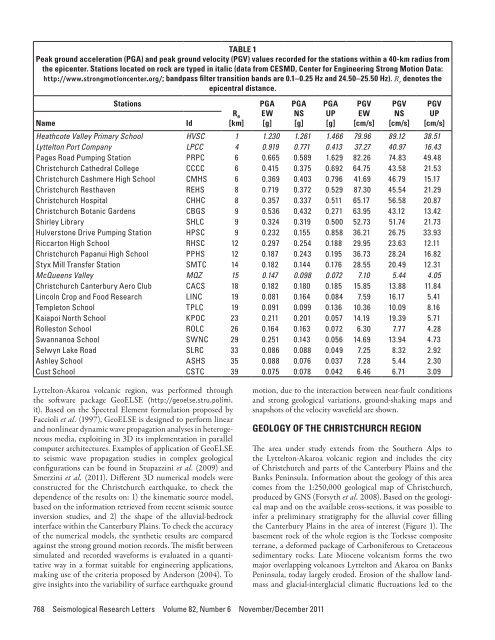Here - Stuff
Here - Stuff
Here - Stuff
You also want an ePaper? Increase the reach of your titles
YUMPU automatically turns print PDFs into web optimized ePapers that Google loves.
TABLE 1Peak ground acceleration (PGA) and peak ground velocity (PGV) values recorded for the stations within a 40-km radius fromthe epicenter. Stations located on rock are typed in italic (data from CESMD, Center for Engineering Strong Motion Data:http://www.strongmotioncenter.org/; bandpass filter transition bands are 0.1–0.25 Hz and 24.50–25.50 Hz). R e denotes theepicentral distance.NameStationsIdR e[km]PGAEW[g]PGANS[g]PGAUP[g]PGVEW[cm/s]PGVNS[cm/s]Heathcote Valley Primary School HVSC 1 1.230 1.261 1.466 79.96 89.12 38.51Lyttelton Port Company LPCC 4 0.919 0.771 0.413 37.27 40.97 16.43Pages Road Pumping Station PRPC 6 0.665 0.589 1.629 82.26 74.83 49.48Christchurch Cathedral College CCCC 6 0.415 0.375 0.692 64.75 43.58 21.53Christchurch Cashmere High School CMHS 6 0.369 0.403 0.796 41.69 46.79 15.17Christchurch Resthaven REHS 8 0.719 0.372 0.529 87.30 45.54 21.29Christchurch Hospital CHHC 8 0.357 0.337 0.511 65.17 56.58 20.87Christchurch Botanic Gardens CBGS 9 0.536 0.432 0.271 63.95 43.12 13.42Shirley Library SHLC 9 0.324 0.319 0.500 52.73 51.74 21.73Hulverstone Drive Pumping Station HPSC 9 0.232 0.155 0.858 36.21 26.75 33.93Riccarton High School RHSC 12 0.297 0.254 0.188 29.95 23.63 12.11Christchurch Papanui High School PPHS 12 0.187 0.243 0.195 36.73 28.24 16.82Styx Mill Transfer Station SMTC 14 0.182 0.144 0.176 28.55 20.49 12.31McQueens Valley MQZ 15 0.147 0.098 0.072 7.10 5.44 4.05Christchurch Canterbury Aero Club CACS 18 0.182 0.180 0.185 15.85 13.88 11.84Lincoln Crop and Food Research LINC 19 0.081 0.164 0.084 7.59 16.17 5.41Templeton School TPLC 19 0.091 0.099 0.136 10.36 10.09 8.16Kaiapoi North School KPOC 23 0.211 0.201 0.057 14.19 19.39 5.71Rolleston School ROLC 26 0.164 0.163 0.072 6.30 7.77 4.28Swannanoa School SWNC 29 0.251 0.143 0.056 14.69 13.94 4.73Selwyn Lake Road SLRC 33 0.086 0.088 0.049 7.25 8.32 2.92Ashley School ASHS 35 0.088 0.076 0.037 7.28 5.44 2.30Cust School CSTC 39 0.075 0.078 0.042 6.46 6.71 3.09PGVUP[cm/s]Lyttelton-Akaroa volcanic region, was performed throughthe software package GeoELSE (http://geoelse.stru.polimi.it). Based on the Spectral Element formulation proposed byFaccioli et al. (1997), GeoELSE is designed to perform linearand nonlinear dynamic wave propagation analyses in heterogeneousmedia, exploiting in 3D its implementation in parallelcomputer architectures. Examples of application of GeoELSEto seismic wave propagation studies in complex geologicalconfigurations can be found in Stupazzini et al. (2009) andSmerzini et al. (2011). Different 3D numerical models wereconstructed for the Christchurch earthquake, to check thedependence of the results on: 1) the kinematic source model,based on the information retrieved from recent seismic sourceinversion studies, and 2) the shape of the alluvial-bedrockinterface within the Canterbury Plains. To check the accuracyof the numerical models, the synthetic results are comparedagainst the strong ground motion records. The misfit betweensimulated and recorded waveforms is evaluated in a quantitativeway in a format suitable for engineering applications,making use of the criteria proposed by Anderson (2004). Togive insights into the variability of surface earthquake groundmotion, due to the interaction between near-fault conditionsand strong geological variations, ground-shaking maps andsnapshots of the velocity wavefield are shown.GEOLOGY OF THE CHRISTCHURCH REGIONThe area under study extends from the Southern Alps tothe Lyttelton-Akaroa volcanic region and includes the cityof Christchurch and parts of the Canterbury Plains and theBanks Peninsula. Information about the geology of this areacomes from the 1:250,000 geological map of Christchurch,produced by GNS (Forsyth et al. 2008). Based on the geologicalmap and on the available cross-sections, it was possible toinfer a preliminary stratigraphy for the alluvial cover fillingthe Canterbury Plains in the area of interest (Figure 1). Thebasement rock of the whole region is the Torlesse compositeterrane, a deformed package of Carboniferous to Cretaceoussedimentary rocks. Late Miocene volcanism forms the twomajor overlapping volcanoes Lyttelton and Akaroa on BanksPeninsula, today largely eroded. Erosion of the shallow landmassand glacial-interglacial climatic fluctuations led to the768 Seismological Research Letters Volume 82, Number 6 November/December 2011
















